A Guam favorite, these vegan CHamoru empanådas are crispy on the outside, and filled with a delicious spicy toasted rice filling. Its beautiful red hue is what makes this different and totally unique to the island of Guam. It’s perfect for on-the-go, quick meal, and the perfect afternoon snack. (Trust me, I ate this a lot after school, it was my favorite!) These take a little bit of time and patience to make, but boy, it’s definitely worth it. One thing I forgot to mention, is that this dish is naturally gluten-free!
I wanted to thank my friend, Crista, for helping me perfect this recipe. She actually gave me her recipe as a guide and gave me some good tips to create this veganized version!
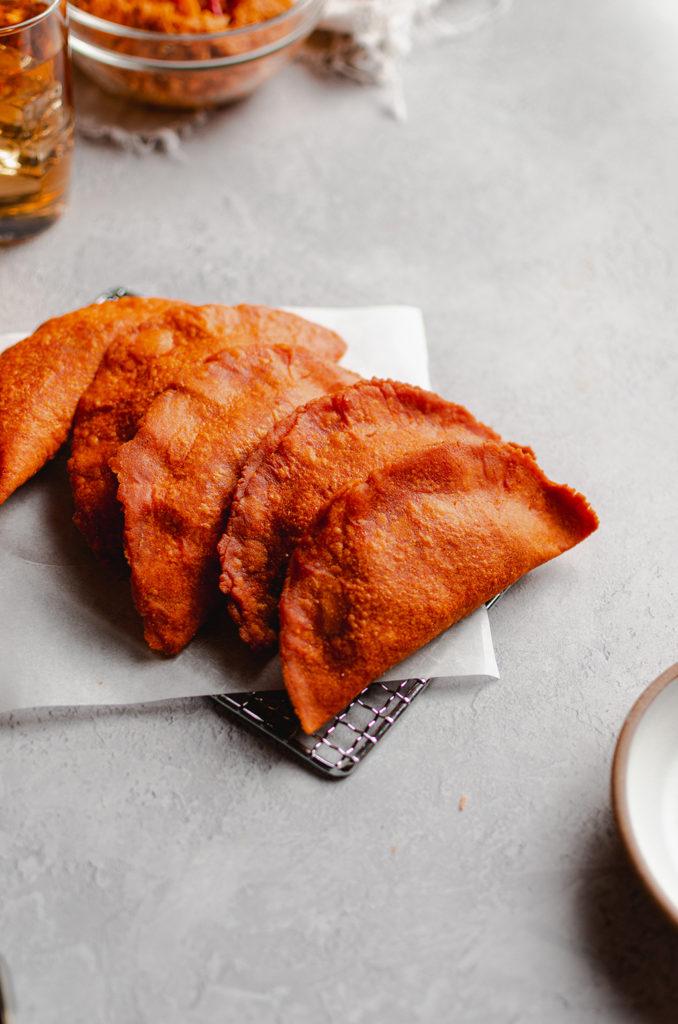
Empanådas (ehm-pah-naw-dah), is very popular around the world. A lot of countries have their own take of an empanåda. But generally speaking, they’re usually a crispy outer crust and usually filled with meat, vegetables, or rice. The red hue on these CHamoru empanadas is something to pay attention to. Not only does it give these empanadas their beautiful red color, but it also adds aroma and flavor.
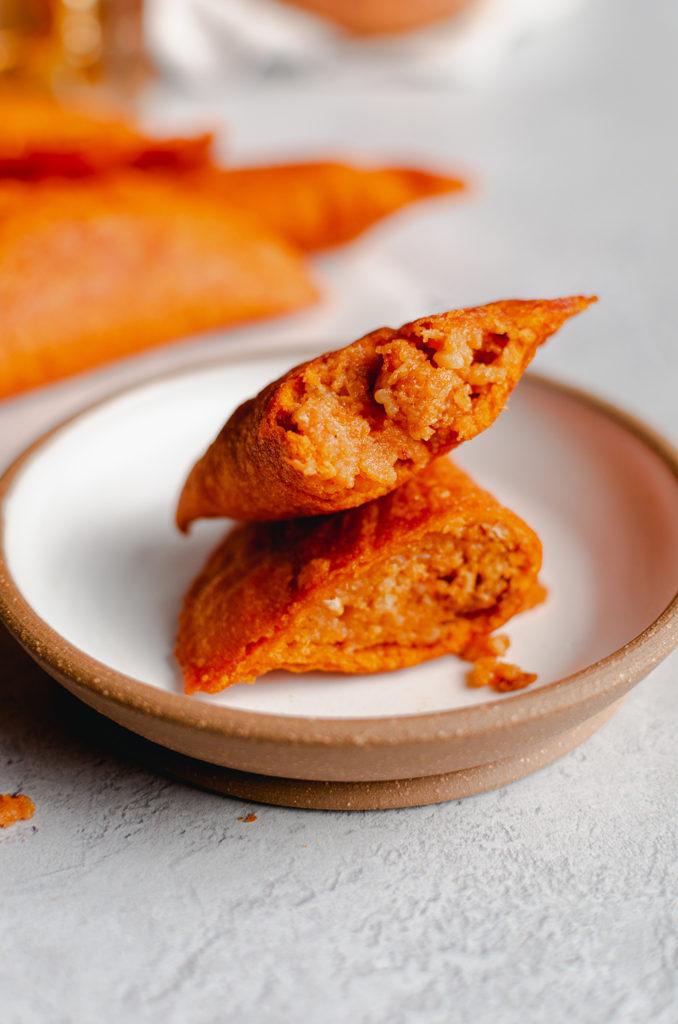
What makes vegan CHamoru empanådas red?
The secret to this is the use of annatto seed powder or in CHamoru, achote. Not only does it give the crust that vibrant red color, but it’s also used in the filling as well. Achote not only adds a natural color, but it gives the dish a nuttier flavor. A lot of Guam dishes use achote to their dishes, and it’s a very distinct taste that you won’t get anywhere else. I actually love the smell of achote, it’s very reminiscent for me, and definitely takes me back home.

What do you fill vegan CHamoru empanådas with?
Another factor that makes this empanada unique is the use of chalakiles (cha-lah-kee-lehs). So what is it? Chalakiles, another comfort food for most CHamoru people, is actually a soup. Think of it as a different kind of rice porridge. It also uses achote/annatto seed powder for that lovely red color and flavor. Filled with toasted rice, chicken, garlic, onions, coconut milk, and some chili peppers. Another delicious dish! Since chalakiles is a form of soup, it’s cooked a bit thicker to fill up the empanadas.
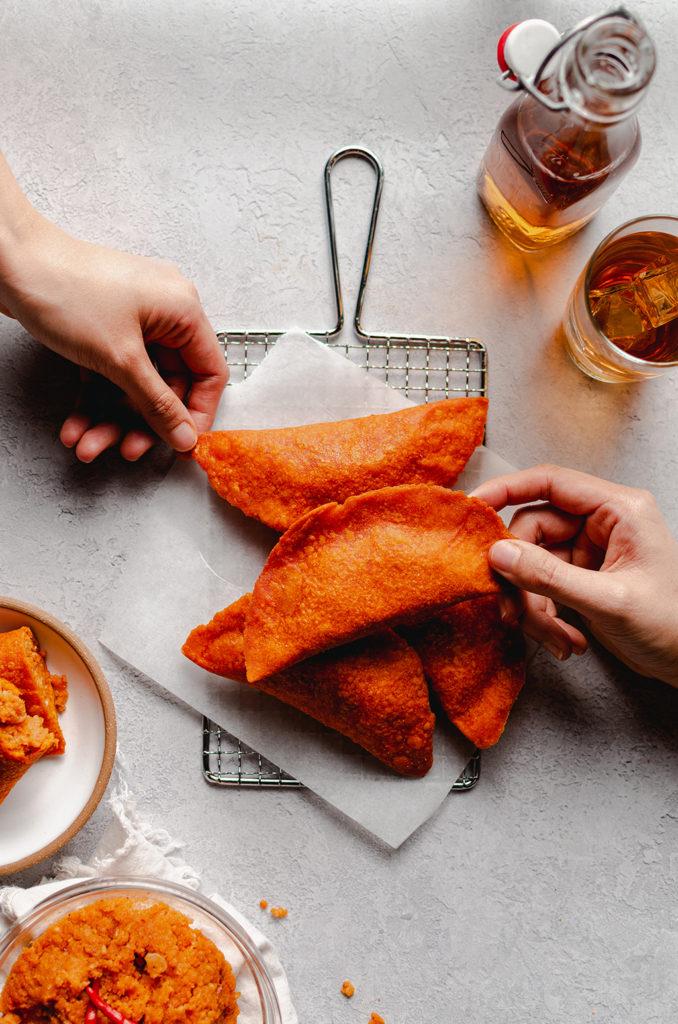
Personally, this is another favorite of mine, and I know, I say this a lot about Guam food. But it’s true, and remaking all these foods from my past is just bringing me closer to home. I ate this mostly as an after school snack. My mom would pick me up, and take me to the nearest mom and pop store for a drink and a snack. Instead of chips, I always picked up an empanada because it was just so filling and I love the spice. Now that I think about it, I think empanadas trained me for my love of spicy food. Depending on the seller, sometimes they were super spicy and sometimes they weren’t. Regardless, it was such a delicious and cheap snack to have.
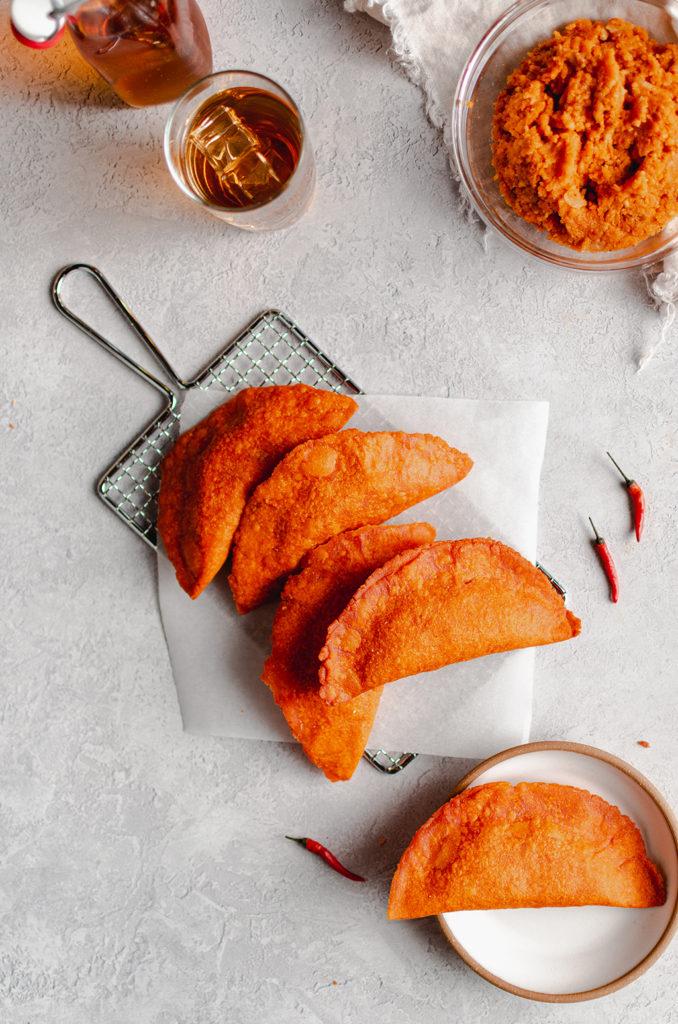
Top tips:
- Toasting your rice before cooking. Yes, it’s an added step, but it adds flavor to the filling. Most recipes like to use cream of rice, as it’s much easier to use. So do what you prefer!
- Add the rice powder a little bit at time, while you stir it in into the broth. If you don’t, it won’t cook properly.
- Chill the chalakiles filling in the fridge overnight. It’s easier to work with when the filling is cold.
- When making the empanada shell, add the broth a little bit at a time. Since we are all using different brands of flour, they might react differently to the amount of broth used.
- Use your hands to feel the dough. You want the empanada shell dough to feel almost like Play-Doh. Not too soft, and not too dry. Another reason to add the broth in batches.
- If you don’t have a tortilla press, you can use two flat-bottom plates and a rolling pin. Place the ball of dough in between two pieces of parchment paper. Use the plates to press it down flat. It will be thick, but use the rolling pin to roll it out thinner.
- After you’re done filling up the empanadas. Freeze it for 1-2 hours. This will help keep the shape of the empanadas before cooking. If you’re not looking to cook all the empanadas right away, you can transfer the hardened empanadas to a freezer-safe bag.
- As you’re frying the empanadas, don’t be tempted to touch them during the early stages. You’ll risk the dough opening and releasing all the filling.
How to fill a CHamoru empanåda

Place dough in the center of the tortilla press and over one piece of parchment paper

Place another parchment paper over the top of the dough

Press down firmly

You should get a fairly thin piece of dough

Carefully, and gently remove the top parchment paper
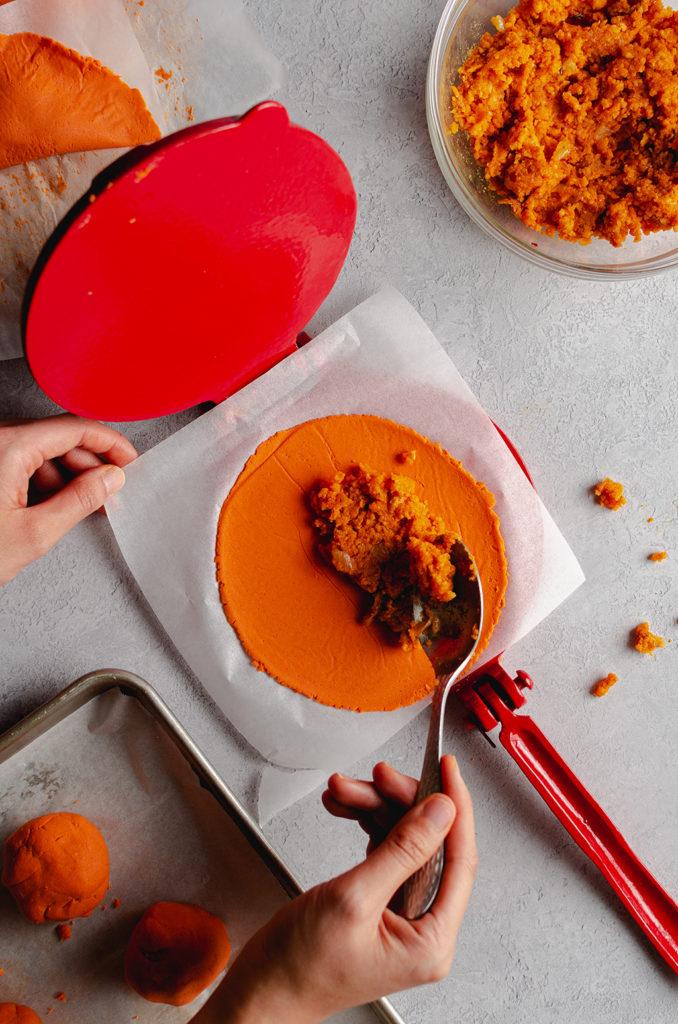
Place filling in the center

Use the parchment paper to bring the bottom half of the shell to meet the top half

Pinch both ends together

Repeat for the rest of the empanada
If you enjoyed this recipe, check out these other CHamoru recipes:
- Vegan Tinaktak
- Buñelos Åga (CHamoru Banana Donuts)
- CHamoru Red Rice
- Vegan CHamoru Latiya (Custard Cake)
If you’d tried this recipe out let me know in the comments! Don’t forget to follow me on Instagram @flouredframe and don’t forget to tag me when you create my recipes! Happy cooking!
As an Amazon Associate I earn from qualifying purchases.
📖 Recipe

CHamoru Empanåda (Fried Red Rice Turnovers)
Equipment
- Mixing bowls
- Fine mesh sieve
- Large saute pan
- High-speed blender food processor
- Large soup pot
- Tortilla press or 2 flat bottom plates, with a rolling pin
- Parchment Paper
- Tongs or spider strainer
- Wire cooling rack
Ingredients
Chalakiles Filling:
- 1 cup soy curls (see notes)
- 3 cups vegetable broth
- ½ cup uncooked white rice (I used Jasmine rice, see notes)
- ½ onion (roughly diced)
- 3 garlic cloves (roughly minced)
- ½ teaspoon poultry seasoning
- ½ teaspoon garlic powder
- ¼ teaspoon chili powder
- 1 ½ teaspoon soy sauce (or tamari)
- ½ packet Sazon Goya Seasoning - Con Culantro Y Achiote
- ½ annatto/achiote powder ()
- Thai Chili peppers or Donne’ Dinanche
- Salt and pepper to taste
- 1-2 cups additional hot water (if needed)
Empanåda Shell:
- 2 cups masa harina
- ½ cup cornstarch
- 1 packet Sazon Goya Seasoning - Con Culantro Y Achiote
- 1 teaspoon salt
- 1 packet annatto/achiote powder ()
- 1 cup vegetable broth
- Oil to deep fry
Instructions
Making the chalakiles filling:
- First heat 1 cup of broth over a stove-top or microwave. Then, in a bowl, rehydrate the soy curls in the hot broth. Set aside until they are properly rehydrated, about 10-15 minutes.
- Meanwhile, toast the rice. Dry toast the rice in a large pan until lightly brown. Stirring constantly so the rice doesn't burn. Optionally, you can also dry toast the rice in a 350° degree oven for about 15 minutes. Stirring every 5 minutes or so, until they're brown and beginning to smell fragrant. Remove from the heat and allow it to cool.
- When the rice has cooled, grind it in a high-speed blender or food processor until you get a cornmeal consistency. I like to have some chunky pieces for more texture! Set aside until ready to use.
- Once the soy curls are rehydrated, drain it through a fine-mesh sieve, and reserve the excess broth. We will use it later.
- Heat 3 tablespoons of oil in a large soup pot over medium heat. Add the soy curls to the pot and season it with poultry seasoning, onion powder, garlic powder, chili powder, soy sauce, salt, and pepper. Saute until the soy curls are browned all over.
- To the pot, add in the onions and garlic. Cook until onions are translucent.
- Add the rest of the broth to the pot, along with the annatto/achiote powder and sazon goya seasoning. Use a whisk to mix until well combined. Allow it to come to a boil and then turn it down to a simmer.
- Add in the toasted rice powder a little bit a time, while continuously stirring. See notes
- After all the rice is mixed in, add in the chili peppers or donne’ dinanche. Add as much as you like! I like mine spicy, so I added a lot.
- Make sure there is enough liquid for the rice to boil, add more hot water if you think it is too thick. Cover the pot and cook for 10 minutes, stirring occasionally.
- After 10 minutes, add salt and pepper. Taste and add more seasoning if needed. If the rice is still gritty, add more water and continue to cook until the rice is cooked thoroughly. You are looking for a thick consistency.
- Transfer the filling to a large bowl, and allow it to come to room temp. Cover the bowl and bring it to the fridge to cool overnight.
Making the empanåda shells:
- Into a large bowl, combine the masa harina, sazon goya seasoning, achote powder, and salt.
- Mix in 1 cup of water, once it starts looking like dough, lightly knead it. Until it is a cohesive dough, there should be no dry flour left. If it's too dry, add in a little broth. If it's too wet, add in a little more masa harina.
- Roll the dough into 1 inch balls (or 2oz/56g balls to be exact). You should get about 10-11 dough balls.
Assembly:
- Using a tortilla press, press the dough in between two pieces of parchment paper. Repeat for the rest of the dough balls. See notes on how to flatten the dough without a tortilla press.
- Gently remove the top parchment paper and add in about a tablespoon of the chalakiles filling onto the center of the flattened dough. Try not to overfill it.
- Use the parchment paper to bring the bottom half of the dough to meet the top half. Press to seal the edges. Do not remove the parchment paper yet! Continue filling the rest of the dough.
- Place the empanådas, with the parchment paper still on them, on a cooking sheet in a single layer. Freeze for 1-2 hours. If you’re not looking to cook these right away, you can transfer the frozen empanådas into a zipped bag.
- When you are ready to cook, fill a deep pot with vegetable oil, enough for the empanåda to be submerged, and place it over medium-low heat or 325° Fahrenheit. Cook the empanådas in batches of 2 or 3’s, don't overcrowd and try not to touch them during this stage. You can risk the shell opening and the filling spilling out. Cook them for about 10 minutes and until nice and crispy.
- Remove the empanådas from the oil, allow them to rest and drain out the excess oil over a wire cooling rack. Continue until all the empanådas are cooked. Serve warm and enjoy!
Notes
- If you don't want to use soy curls to fill up the empanådas, you can also add some potatoes, chickpeas, or even tofu!
- You can use any rice you prefer, I’ve seen some use brown rice as well.
- For ease, most people like to use cream of rice. Use the same amount that’s listed in the recipe. You can also skip steps 2 - 3.
- If you can’t find annatto powder, you can use annatto seeds. You will need to soak the seeds in the broth, that’s listed in the recipe, overnight. If you need it sooner, use a spoon to agitate the seeds to remove the red color off of them. Add the broth to the filling and the empanada shells.
- If you can't find the Mama Sita brand of annatto powder, the equivalent amount per pack is about 2 ½ teaspoons.
- If you don’t add the rice in batches, you’ll risk it not cooking properly.
- If you don’t have a tortilla press, you can use two flat-bottom plates and a rolling pin. Place the ball of dough in between two pieces of parchment paper. Use the plates to press it down flat. It will be thick, but use the rolling pin to roll to about 8-inch in diameter.
- As I mentioned in the directions, if you are not ready to cook all the empanadas, you can keep them in the freezer. Freeze them in a single layer, preferrable on a baking sheet. Once they are frozen solid, transfer them to a freezer-safe zipped bag, and they'll keep in the fridge for a couple of weeks.

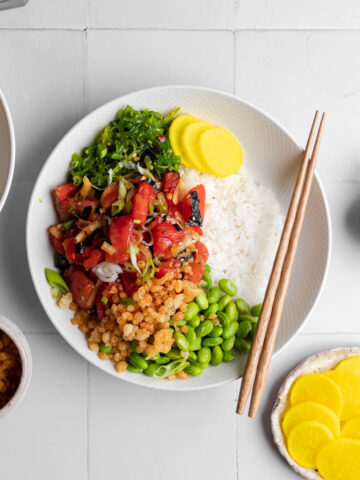

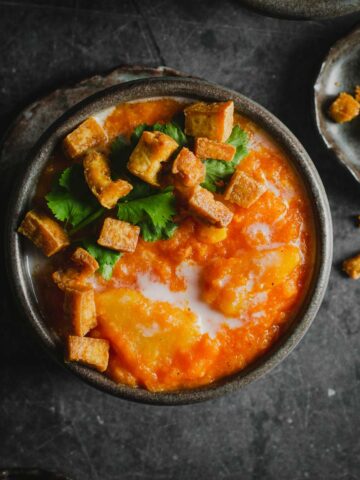
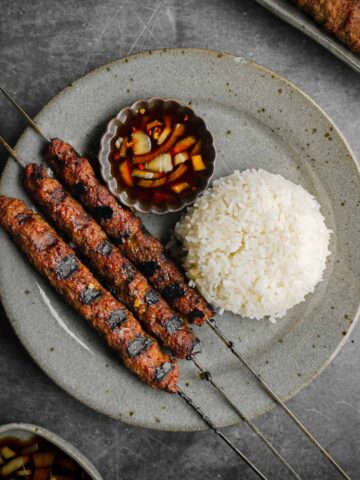
Leave a Reply